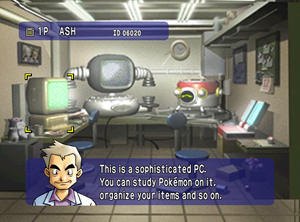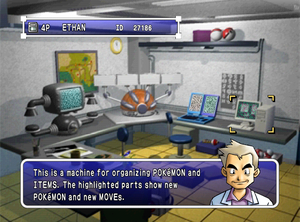Pokémon Lab (Stadium): Difference between revisions
(→PC) |
|||
| Line 49: | Line 49: | ||
===PC=== | ===PC=== | ||
{{ | {{main|PC (Stadium)}} | ||
The PC can be used to move [[item]]s and [[Pokémon (species)|Pokémon]] in [[Generation I]] and {{gen|II}} [[core series]] games connected via [[Transfer Pak]]. | |||
Stadium Japanese | |||
Stadium | The PC features originated in {{jap|Pokémon Stadium|Japanese Pokémon Stadium}}, but they were simply found in the [[main menu]] (not in a PC). All PC features can only be used with a game saved at the [[Pokémon Center]]. | ||
* List | |||
*: The list is able to include Pokémon from the [[party]], [[Pokémon Storage System]] and [[Nintendo 64]] boxes. It is a detailed list of Pokémon, with information such as species, nickname, [[Original Trainer|OT]], ID, [[type]], [[stats]], and [[move]]s. In Stadium 2, [[gender]], [[held item]], and whether a Pokémon is {{pkmn2|Shiny}} are also displayed. There are also ways to sort Pokémon, or to choose which Pokémon are displayed in the list. | |||
* Pokémon | |||
Stadium | *: This feature is used to change the order of Pokémon in the [[party]], [[Pokémon Storage System]], and [[Nintendo 64]] boxes, as well as moving Pokémon between those places. | ||
* Items | |||
*: This feature can be used to change the order of items in the [[Bag]], [[PC]] item storage, and [[Nintendo 64]] item storage, as well as moving items between those places. | |||
* Boxes | |||
*: This feature can be used to change the order of boxes in the Game Boy or Nintendo 64 storage, or moving boxes (effectively moving multiple Pokémon at once) between Game Boy and Nintendo 64 storage. | |||
{| class="roundy" style="margin:auto; background:#{{blue color light}}; border:3px solid #{{Black color dark}}" cellpadding="5" cellspacing="3" | |||
Stadium | |-style="margin:auto;" | ||
Stadium | ! class="roundytop" style="background:#FFF" | [[File:Stadium Japanese PC Main Menu.png|200px]] | ||
Stadium 2 PC Main Menu | ! class="roundytop" style="background:#FFF" | [[File:Stadium English PC Main Menu.png|200px]] | ||
Stadium | ! class="roundytop" style="background:#FFF" | [[File:Stadium 2 PC Main Menu.png|200px]] | ||
|- | |||
Stadium | ! class="roundybottom" style="background:#CCCCCC" | Arrange menu<br>({{color2|000|Pokémon Stadium (Japanese)|Japanese Pokémon Stadium}}) | ||
< | ! class="roundybottom" style="background:#CCCCCC" | PC<br>({{color2|000|Pokémon Stadium (English)|Pokémon Stadium}}) | ||
! class="roundybottom" style="background:#CCCCCC" | PC<br>({{color2|000|Pokémon Stadium 2}}) | |||
|} | |||
===Trade machine=== | ===Trade machine=== | ||
Revision as of 18:12, 11 March 2022
The Pokémon Lab (Japanese: ポケモンけんきゅうじょ Pokémon Laboratory), also shortened to Lab (Japanese: けんきゅうじょ Laboratory) is the version of Professor Oak's Laboratory available in Pokémon Stadium and Pokémon Stadium 2. This place contains several machines able to interact with Generation I and II core series games connected via Transfer Pak.
Several features of the Pokémon Lab were first introduced in the Japanese Pokémon Stadium, although they were not specifically in a laboratory at this point. They were simply part of the main menu of this game.
Terminology
In English, this place is named "Pokémon Lab" at the map in both Stadium and Stadium 2. At the same place in Japanese, it is named "ポケモンけんきゅうじょ" in Stadium and "けんきゅうじょ" in Stadium 2.
Compatibility
- Main article: Transfer Pak#Compatibility
Location
In Pokémon Stadium, the Pokémon Lab is located in the Pokémon Stadium map, at the left side of the screen.
In Pokémon Stadium 2, the Pokémon Lab is located in White City, at the left side of the screen.
Entering the Pokémon Lab
The Pokémon Lab is able to connect to Pokémon core series games using any of the four available Transfer Pak connections (one in each Nintendo 64 game controller). Once the player attempts to enter the Pokémon Lab, a list of the connected game cartridges is displayed. The player is required to choose one of these connected games in order to enter. After entering the Lab, it is also possible to use the cartridge select machine to change the current cartridge.
The player is required to obtain the Pokédex in the core series game before using the Pokémon Lab features. In Pokémon Stadium, if there is a compatible Pokémon game connected via Transfer Pak, the player can enter the Pokémon Lab even with no saved data or with no Pokédex received yet, but then all machines will be unusable except the one used to change the current cartridge. In Pokémon Stadium 2, it is not possible to enter the Pokémon Lab at all with no saved data or before acquiring the Pokédex.
Saving at a Pokémon Center
The PC and trade features are only available if the current connected game was last saved at a Pokémon Center. The Pokédex has no such requirement in Stadium and Stadium 2 (although in the Japanese Pokémon Stadium the Pokédex also required saving at a Pokémon Center).
Features
Cartridge select machine
This unnamed machine can be used to select the current Game Boy cartridge. When the player enters the Pokémon Lab, this screen is also displayed as the player is required to select a cartridge before using other Pokémon Lab features. This is a visually simpler version of the "Game Pak Check" screen that appears at the start of the Stadium games.
In the list of connected cartridges displayed in-game, each Pokémon game version is recognizable by the color or the label (for instance, if Pokémon Red is connected, then the cartridge image displayed in-game has a red label). The saved Trainer name and ID number of each Pokémon game is also displayed (unless there is no saved game yet).
There is a text message informing the player about any compatible Pokémon games that were saved outside of a Pokémon Center.
This list of cartridges also informs the player if any of the four available slots has no connected game at the moment, or if there is any incompatible game connected (including any Game Boy game unrelated to Pokémon).
Pokédex
- Main article: Pokédex (Stadium)
The Pokédex displays information about the Pokémon species. This is much like the Pokédex in the core series games, with the addition of 3D models for each Pokémon.
There is also a number count of "Seen", "Own", and "Caught" Pokémon. While the "Seen" and "Own" numbers work the same way as in the core series, the "Caught" number is the total of species currently available in either the party or the Pokémon Storage System.
The Pokédex in Pokémon Stadium has the option to display Pokémon in either Kanto Pokédex number or alphabetical order, unlike Generation I core series games which only have the numerical order. However, both Pokémon Stadium 2 has the same ordering systems as Generation II core series games (New Pokédex, Old Pokédex, and alphabetical order).
Only in Stadium 2, there is also a Pokémon search feature, much like in the Generation II core series games. The Unown Mode (named "Unowndex" in Pokémon Stadium 2) is also available if the player obtained it in the connected Generation II game.
PC
- Main article: PC (Stadium)
The PC can be used to move items and Pokémon in Generation I and II core series games connected via Transfer Pak.
The PC features originated in Japanese Pokémon Stadium, but they were simply found in the main menu (not in a PC). All PC features can only be used with a game saved at the Pokémon Center.
- List
- The list is able to include Pokémon from the party, Pokémon Storage System and Nintendo 64 boxes. It is a detailed list of Pokémon, with information such as species, nickname, OT, ID, type, stats, and moves. In Stadium 2, gender, held item, and whether a Pokémon is Shiny are also displayed. There are also ways to sort Pokémon, or to choose which Pokémon are displayed in the list.
- Pokémon
- This feature is used to change the order of Pokémon in the party, Pokémon Storage System, and Nintendo 64 boxes, as well as moving Pokémon between those places.
- Items
- This feature can be used to change the order of items in the Bag, PC item storage, and Nintendo 64 item storage, as well as moving items between those places.
- Boxes
- This feature can be used to change the order of boxes in the Game Boy or Nintendo 64 storage, or moving boxes (effectively moving multiple Pokémon at once) between Game Boy and Nintendo 64 storage.
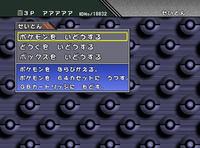
|
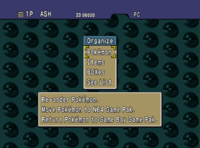
|
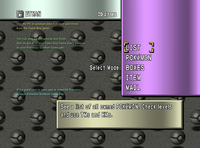
|
|---|---|---|
| Arrange menu (Japanese Pokémon Stadium) |
PC (Pokémon Stadium) |
PC (Pokémon Stadium 2) |
Trade machine
The trade machine can be used to trade Pokémon between two compatible games connected via Transfer Pak. In order to trade Pokémon, both players must have obtained the Pokédex and last saved their games at a Pokémon Center. It is possible to trade Pokémon that are located either at the party or at the Pokémon Storage System.
The player one (the player using the game controller connected in the first Nintendo 64 slot) is able to control the whole trade, including the choice of the Pokémon from both games.
- In Japanese Pokémon Stadium, there is no Pokémon trade feature.
- In Pokémon Stadium, this machine can be used to trade Pokémon between Generation I games.
- In Pokémon Stadium 2, this machine can be used to trade Pokémon between Generation I or Generation II games, including from one generation to another.
Much like in the Time Capsule from Pokémon Gold, Silver, and Crystal, if a Pokémon species was introduced in Generation II, or it has any moves introduced in Generation II, it may not be traded to a Generation I game, whereas a Pokémon holding an item may be traded normally between those two generations. Generation I games have no support for held items, but the held item data is internally stored as the Pokémon's catch rate value, therefore held items are retained in case the Pokémon are traded to Generation II games later.
After each trade, the player has three options:
- Save and quit
- Save and continue
- Quit without saving
In other languages
| |||||||||||||||||||||
| |||||||||||||
